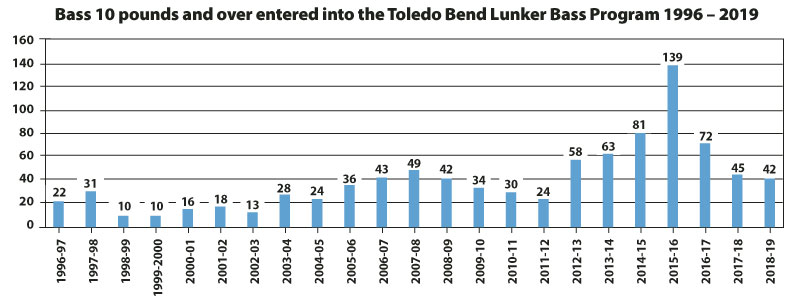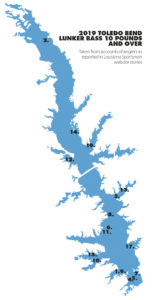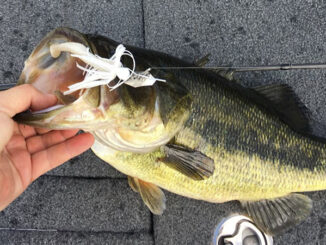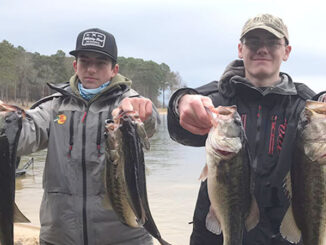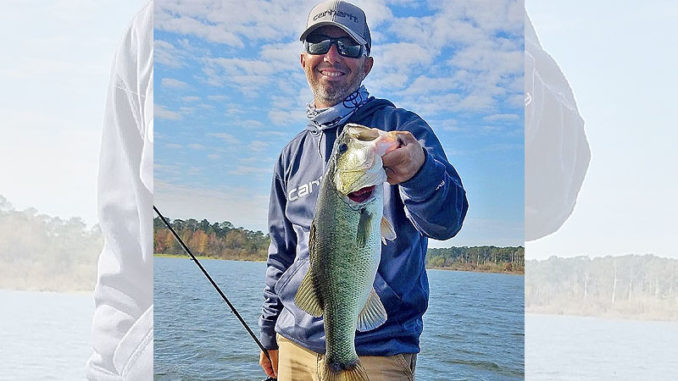
Extended periods of low water on the sprawling Sabine River reservoir have usually been followed by tremendous fishing for lunker bass. Will anglers’ focus on those huge fish during the 2020 prespawn and spawn be rewarded?
February is here, and that usually means it’s prespawn time for bass on Toledo Bend Reservoir on the Louisiana-Texas border.
The prespawn is chiefly defined as the beginning of the migration when bass move shallow, slowly, by first staging in deeper areas where submerged creek channels, ditches and sloughs meet the runways leading to the many coves and small lakes on both sides of the 185,000-acre reservoir on the Sabine River.
Darold Gleason of Many knows how to catch Toledo Bend’s big prespawn largemouths. Last Feb. 22-23, Gleason, a 37-year-old guide on Toledo Bend, won a BASS Central Open there with a two-day total of 10 bass that weighed 40 pounds, 2 ounces.
“Without a doubt, the final day was the best day of tournament fishing I experienced out there at the time,” Gleason said. “On that day alone, I brought 25 pounds, 3 ounces to … the weigh-in.”
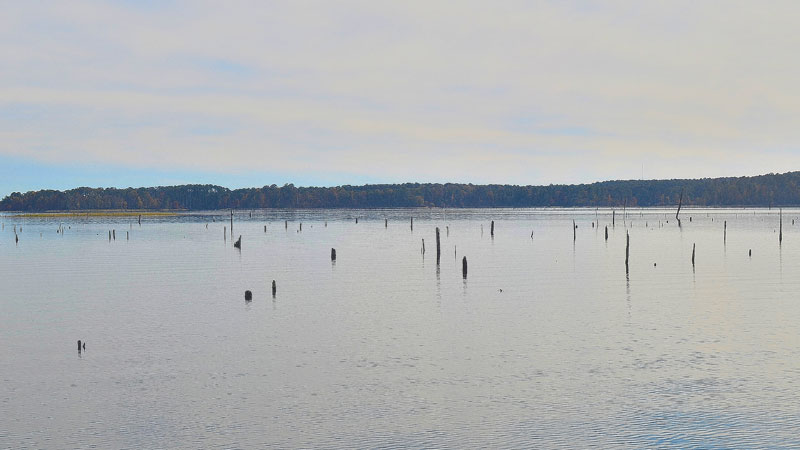 Gleason’s win was worth $42,800 in winnings and earned him a berth in the 2020 Bassmaster Classic next month on Alabama’s Lake Guntersville.
Gleason’s win was worth $42,800 in winnings and earned him a berth in the 2020 Bassmaster Classic next month on Alabama’s Lake Guntersville.
What will 2020 bring
Gleason said that water temperatures at the lake weren’t terribly cold early in 2020, with 55 degrees in early January being the coldest water he found.
“We all know bass begin spawning in the low 50s … therefore, anglers may wish to schedule fishing around the full moon in February and even look to the shallows, especially if these warm water temperatures continue. We could experience an early spawn this year.”
Despite the continued woes expressed online by bass anglers about finding and catching Toledo Bend bass, Gleason’s 40 pounds over two days is nothing to snub your nose at. Neither was the five-fish limit weighing 25.21 pounds caught during the Keith’s Toledo Bend Tackle’s Battle on the Border fishing tournament last February.
The major complaint voiced by anglers catching fewer bass appears to be related to lower water levels the lake has experienced for the past 18 months during spillway repairs. For most of December 2019 and early January 2020, the lake level has remained at or near 165 feet, some 7 feet below normal-pool stage of 172 feet. Also, a lack of submerged vegetation continues and doesn’t appear to be going away anytime soon.
“The work on the spillway repairs is over, and pallets were being removed in early January,” said biologist Villis Dowden, who oversees Toledo Bend for the Louisiana Department of Wildlife and Fisheries. “All we are waiting on now are winter rains to begin filling the impoundment up to full-pool stage later in 2020.”
Toledo Bend lunkers
No doubt, many Louisiana and Texas anglers have been mesmerized by the many bass 10 pounds and better taken over the years at Toledo Bend. The numbers have been quite startling and were noted by Bassmaster magazine when it ranked Toledo Bend as the No. 1 lake nationally in 2015 and 2016.
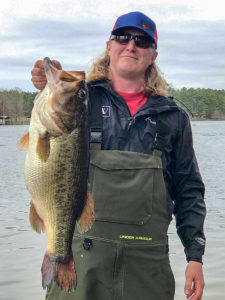
From May 2018 to May 2019, 42 bass weighing between 10 and 14 pounds or better were recorded in the Toledo Bend Lunker Bass Program, conducted by the Toledo Bend Lake Association. The Association awards anglers free replicas of bass 10 pounds or more if they are brought to specific weigh stations and eventually released alive back into the lake.
In February, March and April 2019, 22 bass in that category were recorded, including a huge 14-pounder, the largest of the season, taken March 2 by DeQuincy’s Sean Kennon.
Patrick Bonin, former editor of Louisiana Sportsman wrote stories about 19 of those lunkers, including the general location where they were caught and the lures that fooled them. Although precise locations were difficult to pinpoint, the general areas remain important for anglers who want to land the bass of a lifetime.
10 Pound Plus Bass 2019
Taken from accounts of anglers as reported in Louisiana Sportsman Website Stories| No. | Date | Weight (pounds) | Angler | Location | Lure |
|---|---|---|---|---|---|
| 1 | 2/4/2019 | 10.96 | Jim Miers | Mills Creek Area | Texas-rigged Zoom Lizard |
| 2 | 2/4/2019 | 11.41 | Jared Sattler | Circle Drive Area | Texas-rigged 6-inch plastic worm |
| 3 | 2/15/2019 | 10.41 | Kyle Alexander | Turtle Beach Area | Jerkbait |
| 4 | 3/2/2019 | 14 | Sean Kennon | South end - Texas side | Santone Lures 3/4-ounce peanut butter-and-jelly football jig |
| 5 | 3/8/2019 | 10.43 | Chance Vicknair | South end - Texas side | Strike King 6XD Sexy Shad crankbait |
| 6 | 3/8/2019 | 10.52 | Cody Pitt | Housen Area | 3/4-ounce V&M Big LeBoom chartreuse-and-white spinnerbait |
| 7 | 3/8/2019 | 10.53 | Tyler Wilkerson | South end - Louisiana side | Carolina-rigged Zoom Baby Brush Hog - South Africa special color |
| 8 | 3/9/2019 | 10.01 | David Burton | Boone's Crossing area | Cotton Cordell Big O crankbait - Firetiger color |
| 9 | 3/20/2019 | 10.27 | Darren Burns | Mills Creek Area | Wacky-rigged watermelon-red Zoom Trick Worm |
| 10 | 3/20/2019 | 10.02 | Robert Prejean | Sandy Creek Area | Texas-rigged (weightless) watermelon-candy Yum Dinger |
| 11 | 3/20/2019 | 10.26 | Aaron Gay | Housen Area | Carolina-rigged Zoom Trick Worm green pumpkin with red flakes |
| 12 | 3/20/2019 | 10.07 | Richard Gautreaux | Holly Park Marina Area - Texas side | Wacky-rigged pumpkin-purple flake 6-inch Yum Worm |
| 13 | 3/25/2019 | 10.46 | Garret Perkins | Negreet Area | Texas-rigged white Cajun Lures Craw with 3/8-ounce weight |
| 14 | 3/30/2019 | 10.03 | Brett Trouille | 12-15 Area | Texas-rigged white Zoom Craw |
| 15 | 3/30/2019 | 10.72 | Brayden Cruze | 6 Mile Area | Green-pumpkin Zoom Speed Craw |
| 16 | 4/1/2019 | 10.41 | Craig Broussard | Louisiana side of Toledo Bend | Wacky-rigged watermelon-purple flake 5-inch Senko |
| 17 | 4/6/2019 | 11.12 | John Reber | Pirate's Cove Area | Texas-rigged 8-inch black-and-blue Yum Stickbait |
| 18 | 4/16/2019 | 11.15 | Eddie Jarrell | Mid-lake Toledo Bend | Carolina-rigged watermelon-red 7-inch Zoom Magnum Trick Worm |
| 19 | 4/27/2019 | 10.98 | John Gillard | San Miguel Area | Texas-rigged blueberry Zoom Lizard |
The top spots
Year after year, these areas have become important, consistently delivering lunker bass to successful anglers: Indian Mounds, Negreet Creek, Housen Bay, Six Mile and areas near the Toledo Bend dam on the southern end.
Will Toledo Bend ever again reach the level when 139 bass entered in the program during the 2015-16 season? That possibility depends on the success of periodic drawdowns. Dowden pointed out that increasing numbers of lunker bass taken over the years after periods of doubts or drawdowns.
In 1996, the lake level dropped to 165, followed by two more lower lake levels occurring in the 2006 (162) and 2011 (159).
“In the years following these low-water drawdowns, there were increases in lunker bass recorded in the Toledo Bend Lunker Bass Program,” Villis said.
“The 139 bass recorded by the program in 2015-16 occurred following the lowest-ever recorded lake levels in 2011, when about one-third of the lake’s bed was exposed — the lowest drawdown on record.”
“Periodic drawdowns are very important to lakes as they expose the lake bed to sunlight, enabling new growth to eventually be submerged and offer rich habitat for baitfish and bass.”
Toledo Bend bass biology
As for the health of the bass fishery at Toledo Bend, Dowden is very optimistic.
“The results of our electrofishing surveys last spring were great,” Dowden said. “Our catch rate per hour (CPUE) was 208 bass — quite a bit more bass than we found in 2018 (137). We found lots of bass at 7 to 9 inches and quite a few at 16 inches and above.”
Dowden also said that gill-net samples have been great, with two bass netted that weighed more the current Louisiana state record of 15.97 pounds.
Dowden said the latest (2019) determination was that some 34.5% of Toledo Bend bass demonstrated Florida bass genetics — pure Florida or Florida-Northern hybrids.
“We normally request 823,000 Florida fingerlings each year here at Toledo Bend,” he said. “We had quite a bit over that amount in 2019, as some 1,002,430 fingerlings were stocked from the Louisiana hatchery. Texas provided 501,273 fingerlings in 2019.”
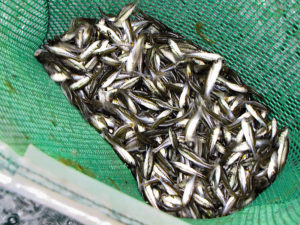
Dowden emphasized that the main purpose of stocking Florida-strain fingerlings is to affect the genetic pool of bass in Toledo Bend.
February, March, April tips
Gleason’s strategies for fishing the prespawn and spawn at Toledo Bend depends chiefly on where anglers decide to fish in February and March.
“Anglers tend to find shallower waters north of Pendleton Bridge during the prespawn and therefore will fish this area differently than the deeper waters south of the bridge,” he said.
“North of the bridge, anglers will be targeting waters 4 to 8 feet deep, and bass will react well to Rat-L-Traps in red and crawfish colors and slow-rolled spinnerbaits. Plastics used in the northern waters also include Texas-rigged lizards.”
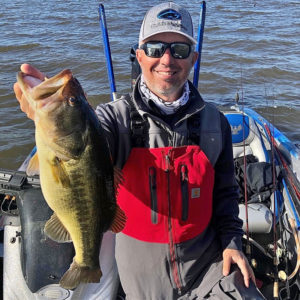
On the southern end, anglers will find prespawn bass using submerged creek channels and ditches leading to shallower spawning waters in the coves, and successful depths include 12 and 18 feet of water. South of the bridge, Gleason will have a variety of lures tied on depending on how the bass react on any given day.
“What I used during the February tournament is a fine example of what I will continue to use during this prespawn,” he said.
Gleason caught his winning bass last years fishing depths to 24 feet with the following lures: Strike King 6XD crankbaits in blue-chartreuse; 6th Sense C-15 crankbaits in blue-chartreuse; 3/4-ounce V&M football jigs in blue shadow with a green-pumpkin V&M J-Bug trailer; Carolina rigs with either V&M Gleason Candy Pork Shads or watermelon-candy red V&M Chop Sticks.
Shallow beds
When bass are on the shallow beds, Gleason uses a different strategy.
“I’ll use that trolling motor and look for likely bedding locations, including light spots and sandy areas,” he said. “And without all the submerged grass, I have found bedding bass relating to just about any other type of shallow structure, including piers, other wooden structures and just about any other type of structure with shade to attract spawning bass.”
When he finds a bedded bass, Gleason will often use white lures, such as V&M’s J-Bug on a 4/0 flipping hook under a ¼- or 3/8-ounce tungsten sinker on braided line.
“Bedding bass are notoriously wary, and I may have to change up presentations a few times before getting the female to bite the lure,” he said. “Being patient with bedding bass is the key to catching them.”
Gleason has had the most success of any Toledo Bend angler when it comes to big bass over the past decade or so. He has caught seven bass at 10 pounds or better since 2007.
In 2015-16, Gleason scored on two lunkers in March: an 11.71-pounder and a 10.78-pound lunker. In 2014, he caught two lunkers over 11 pounds. He also caught a 10.09-pounder in 2013, an 11.28-pounder in 2009; and one weighing 10.22 pounds in 2007.
To set up a guided fishing trip with Darold Gleason of Gleason Fishing, call 337-397-8860.
